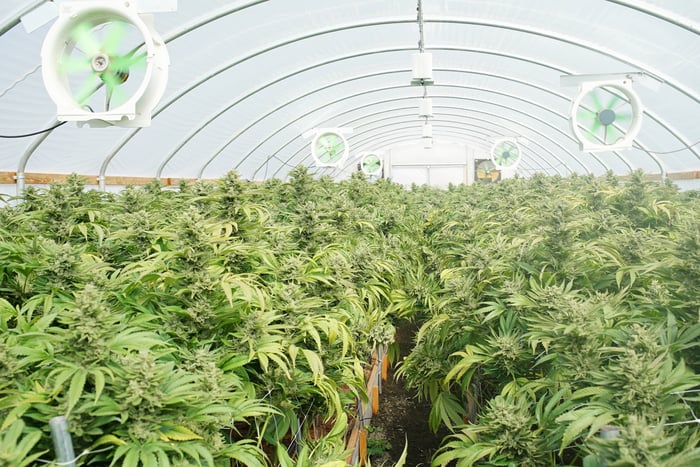Though the marijuana industry has seemingly grown by leaps and bounds over the past couple of years, that growth rate is about to kick into overdrive. After a long wait, Canada's Senate overwhelmingly voted in favor of the Cannabis Act on June 7, which would make adult-use marijuana legal in our neighbor to the north.
The Senate's vote did come with more than 40 amendments from when the bill was first received from the House of Commons, but given that the Senate was viewed by pundits as the final hurdle for legal cannabis in Canada, it looks to be just a matter of time before recreational weed gets the green light. That means the potential for $5 billion (or more) to flood into the legal pot industry in Canada each year.

Image source: Getty Images.
With dollar signs dancing in their heads for more than a year now, Canada's growers have been expanding their capacity in anticipation of that green light. These growers want to both front-load initial production in order to garner loyal consumers and lucrative long-term deals with provinces and retailers, as well as maximize their long-term peak production in order to reach as many consumers as possible.
As of just over two weeks ago, eight Canadian pot stocks were on track to deliver in excess of 100,000 kilograms of cannabis-equivalent production (i.e., dried cannabis, oils, extracts, and other cannabis-related products). Today, the number of growers expected to top 100,000 kilograms annually remains the same, but peak production estimates continue to creep higher. Just among these eight producers, Canada could be looking at an annual run rate of 1.8 million kilograms a year by 2020.
The big three
In terms of pot stocks, there are the three biggest growers, and then essentially everyone else.

Image source: Getty Images.
These "big three" growers are:
- Canopy Growth Corp. (CGC 1.28%): So far in 2018, Canopy Growth Corp. has tripled its licensed production capacity to 2.4 million square feet, and it plans to boost its peak licensed capacity to 5.7 million square feet. Though Canopy -- the marijuana stock with the largest market cap -- has been a bit hush-hush about its total production capacity per year in kilograms, I'd estimate that in the neighborhood of 500,000 kilograms, give or take 40,000 kilograms, isn't out of the question.
- Aurora Cannabis (ACB -1.15%): With regard to peak production, Aurora Cannabis may actually take the crown over Canopy Growth. Currently, Aurora Cannabis is on track for around 430,000 kilograms in peak annual production, which includes its recently announced Aurora Sun facility in Medicine Hat, Alberta. This monstrous 1.2-million-square-foot facility will be built using the knowledge of Aurora's wholly owned greenhouse consulting and construction subsidiary Larssen, and yield 150,000 kilograms a year. Aurora Cannabis has also agreed to buy Ontario-based MedReleaf (NASDAQOTH: MEDFF) for $2.5 billion in an all-share deal. Adding MedReleaf's peak annual production of 140,000 kilograms pushes its yield to an estimated 570,000 kilograms per year.
- Aphria (NASDAQOTH: APHQF): Rounding out the big three is Aphria, which modestly expanded its peak capacity earlier this month. Having previously forecast 230,000 kilograms a year, Aphria now anticipates 255,000 kilograms of production, primarily as a result of the announced construction of its Extraction Centre of Excellence for the sale of cannabis concentrates. This comes atop its organic build-out of Aphria One, and its partnership with Double Diamond Farms, known as Aphria Diamond, which are expected to yield 100,000 kilograms and 120,000 kilograms per year, respectively.
Combined, these three growers could produce anywhere from 1.3 million kilograms to 1.4 million kilograms of cannabis a year by 2020, inclusive of Aurora's acquisition of MedReleaf.
Meanwhile, there are other big players expected to top 100,000 kilograms of annual production.

Image source: Getty Images.
Everyone else
- MedReleaf: As noted above, MedReleaf is being acquired by Aurora Cannabis in an all-share buyout. Organically, MedReleaf was on track for about 35,000 kilograms of production between its Markham and Bradford facilities, but added an estimated 105,000 kilograms with the purchase and ongoing retrofit of the Exeter facility in Ontario. Added together, this is where its 140,000 kilograms of peak production comes from.
- The Green Organic Dutchman (TGOD.F -23.08%): Next up is The Green Organic Dutchman, which went public earlier this year and became the largest pot stock IPO in history. The bulk of The Green Organic Dutchman's production should come from its Quebec Project, which covers 820,000 square feet and should yield approximately 102,000 kilograms. Its smaller Ontario Project, once fully expanded, will cap out at 150,000 square feet of growing capacity and 14,000 kilograms of annual production. Combined, that's 116,000 kilograms a year.
- Emerald Health Therapeutics (EMHT.F): Along the same lines as Canopy Growth, Emerald Health Therapeutics is a bit of an enigma in terms of total production. The company's partnership with Village Farms International, known as Pure Sunfarms, is currently retrofitting a 1.1-million-square-foot facility, previously used for growing tomatoes, to produce cannabis. This facility is expected to yield about 75,000 kilograms at its peak. Emerald Health is also constructing its Metro Vancouver facility, which will span 500,000 square feet. This wholly owned facility has no specific peak production estimates, but I'd opine that a slightly better yield per square foot relative to the retrofitted facility is likely. Thus, I'd peg 40,000 kilograms at Metro Vancouver, or 115,000 kilograms combined, as a reasonable peak
- OrganiGram Holdings (OGI 1.07%): New Brunswick-based OrganiGram Holdings is expected to yield 113,000 kilograms annually once its Moncton facility is complete in April 2020. Though it'll be among the last to finish its expansion projects, OrganiGram is also the only grower to focus on building out a single grow site. That should help keep its costs down and push its yield-per-square-foot higher than its peers.
- Hydropothecary: Last, but not least, Hydropothecary is expected to produce 108,000 kilograms a year once its 1.3 million square feet of growing space is at peak capacity. Most of this production will come from the expansion of a 1-million-square-foot facility adjacent to its existing facility in Quebec.

Image source: Getty Images.
Excluding MedReleaf, which was included in the previous section, these second-tier players could have an annual production run rate in the neighborhood of 450,000 kilograms of cannabis by 2020.
If we were to combine the production capacity of these eight growers, understanding that there's some guesswork and fluidity to these figures, we could be looking at around 1.8 million kilograms of marijuana produced annually by the end of 2020.
While that might sound fantastic, it's also a bit worrisome given that Health Canada has forecast domestic demand of just 1 million kilograms of cannabis. Exports and product differentiation -- i.e., the production of oils and extracts as opposed to dried cannabis -- are expected to play a key role in reducing potential domestic oversupply. The worry, though, is that we don't know with any certainty whether or not this oversupply will be completely abated, or if a glut of sorts will develop. With no developed country having legalized marijuana before, investors will need a bit of research and guesswork at this point.





